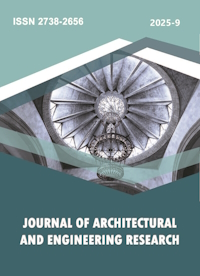Application of Basalt Fibers and Cement Through FDR Technology in the km 93+880 Section of the M2 Yerevan–Goris–Meghri Highway
DOI:
https://doi.org/10.54338/27382656-2025.9-03Keywords:
Basalt fibers, cement, additives, Full-Depth Reclamation (FDR) technology, asphalt concreteAbstract
The maintenance and rehabilitation of road networks remain among the most critical challenges in the global road construction sector, as increasing traffic volumes and pavement deterioration demand efficient solutions. Road repair and maintenance are essential not only for ensuring traffic safety but also for optimizing economic expenditures. Full-Depth Reclamation (FDR) is a pavement rehabilitation method in which the existing pavement—comprising the asphalt concrete surface, the base layer, and in some cases, additional base and subbase layers—is uniformly pulverized and blended to a predetermined depth, producing an improved, homogeneous base material. FDR is carried out entirely on-site without the application of heat. The treatment depth depends on the structure of the existing pavement and typically ranges from 100 to 300 mm. Compared to other technologies for rehabilitating flexible pavements, FDR significantly reduces the need for importing new materials, lowers energy consumption, and decreases harmful atmospheric emissions. The implementation of FDR in road construction began several decades ago, initially involving various mechanisms for pavement treatment, including pulverizers, scarifiers, mixers, and a range of additives. However, the adoption of high-powered self-propelled reclaimers provided significant momentum to the use of FDR, enabling deeper processing, higher productivity, and more reliable control of the stabilization process when additives are introduced. This article examines the impact of applying Full-Depth Reclamation (FDR) technology with cement and basalt fibers as additives on the strength and crack resistance of road pavements. The km 93+880 section of the M2 Yerevan–Goris–Meghri highway in the Republic of Armenia was selected as the experimental test site.
Downloads
References
H.H. Gyulzadyan, A.S. Ghazaryan, Analysis of International Practice in the Application of Asphalt Concrete Recycling Technology. Scientific Papers of the National University of Architecture and Construction of Armenia, 3 (66), 2017, 32-39.
A. Behnood, M.M. Gharehveran, F.G. Asl, M. Ameri, Effects of Copper Slag and Recycled Concrete Aggregate on the Properties of CIR Mixes with Bitumen Emulsion, Rice Husk Ash, Portland Cement and Fly Ash. Construction and Building Materials, 96, 2015, 172-180. Doi: https://doi.org/10.1016/j.conbuildmat.2015.08.021
H.H. Gyulzadyan, Kh.S. Chkolyan, Analysis of Road Pavements’ Full Depth Reclamation Experience. Scientific Papers of the National University of Architecture and Construction of Armenia, 1 (82), 2022, 31-40.
M. Bocci, A. Grilli, F. Cardone, A. Graziani, A Study on the Mechanical Behaviour of Cement–Bitumen Treated Materials. Construction and Building Materials, 25 (2), 2011. 773-778. Doi: https://doi.org/10.1016/j.conbuildmat.2010.07.007
A. Graziani, C. Godenzoni, F. Cardone, M. Bocci, Effect of Curing on the Physical and Mechanical Properties of Cold-Recycled Bituminous Mixtures. Materials & Design, 95, 2016, 358-369. Doi: https://doi.org/10.1016/j.matdes.2016.01.094
B. Dolzycki, M. Jaczewski, C. Szydlowski, The Long-Term Properties of Mineral-Cement-Emulsion Mixtures. Construction and Building Materials, 156, 2017, 799-808. Doi: https://doi.org/10.1016/j.conbuildmat.2017.09.032
A. Ibrahim, S. Faisal, N. Jamil, Use of basalt in asphalt concrete mixes. Construction and Building Materials, 23 (1), 2009, 498-506. Doi: https://doi.org/10.1016/j.conbuildmat.2007.10.026
N. Morova, Investigation of Usability of Basalt Fibers in Hot Mix Asphalt Concrete. Construction and Building Materials, 47, 2013, 175-180. Doi: https://doi.org/10.1016/j.conbuildmat.2013.04.048
Y. Zheng, Y. Cai, G. Zhang, H. Fang, Fatigue Property of Basalt Fiber-Modified Asphalt Mixture under Complicated Environment. Journal of Wuhan University of Technology-Mater. Sci. Ed., 29 (5), 2014, 996-1004. Doi: https://doi.org/10.1007/s11595-014-1033-1
C. Gao, W. Wu, Using ESEM to Analyze the Microscopic Property of Basalt Fiber Reinforced Asphalt Concrete. International Journal of Pavement Research and Technology, 11(4), 2018, 374-380. Doi: https://doi.org/10.1016/j.ijprt.2017.09.010
G. Bergeron, Performance des techniques de retraitement en place et de recyclage à froid au Québec, in: Congrès annuel de 2005 de l’Association des transports du Canada à Calgary (Alberta), 2005.
T. Czigány, Trends in Fiber Reinforcements – the Future Belongs to Basalt Fiber. Express Polymer Letters, 1 (2), 2007, 59. Doi: https://doi.org/10.3144/expresspolymlett.2007.11
Q. Liu, M.T. Shaw, R.S. Parnas, A-M Mcdonnell, Investigation of Basalt Fiber Composite Mechanical Properties for Applications in Transportation. Polymer Composites, 27 (1), 2006, 41-48. Doi: https://doi.org/10.1002/pc.20162
T. Czigány, Discontinuous Basalt Fiber-Reinforced Hybrid Composites, in: K. Friedrich, S. Fakirov, Z. Zhang (eds.), Polymer Composites: From Nano to Macro-scale. Springer, Boston, MA, 2005, 309-328. Doi: https://doi.org/10.1007/0-387-26213-X_17
V. Dhand, G. Mittal, K.Y. Rhee, S.J. Park, D. Hui, A Short Review on Basalt Fiber Reinforced Polymer Composites. Composites Part B: Engineering, 73, 2015, 166-180. Doi: https://doi.org/10.1016/j.compositesb.2014.12.011
A. Dorigato, A. Pegoretti, Fatigue Resistance of Basalt Fbers-Reinforced Laminates. Journal of Composite Materials, 46 (15), 2012, 1773-1785. Doi: https://doi.org/10.1177/0021998311425620
V.V. Gur'ev, E.I. Neproshin, G.E. Mostovoi, The Effect of Basalt Fiber Production Technology on Mechanical Properties of Fiber. Glass and Ceramics, 58, 2001, 62-65. Doi: https://doi.org/10.1023/A:1010901615857
T. Deak, T. Czigany, Chemical Composition and Mechanical Properties of Basalt and Glass Fbers: A comparison. Textile Research Journal, 79 (7), 2009, 645–651. Doi: https://doi.org/10.1177/0040517508095597
Xin Yan, Ronghua Ying, Jian Jin, Yuntai Zhang․ Study on Cracking Resistance of Basalt Fiber-Reinforced Microbond Asphalt Macadam․ Advances in Civil Engineering, 2021, 6647766. Doi: https://doi.org/10.1155/2021/6647766
K. Singha, A Short Review on Basalt Fiber. International Journal of Textile Science, 1 (4), 2012, 19-28. Doi: https://doi.org/10.5923/j.textile.20120104.02
A. Cetin, B. Evirgen, A. Karslioglu, A. Tuncan. The Effect of Basalt Fiber on the Performance of Stone Mastic Asphalt. Periodica Polytechnica Civil Engineering, 65 (1), 2021, 299-308. Doi: https://doi.org/10.3311/PPci.14190
S.P. Dunuweera, R.M Rajapakse, Cement Types, Composition, Uses and Advantages of Nanocement, Environmental Impact on Cement Production, and Possible Solutions․ Advances in Materials Science and Engineering, 2018. Doi: https://doi.org/10.1155/2018/4158682
Downloads
Published
How to Cite
Issue
Section
License
Copyright (c) 2025 Khachik Chkolyan

This work is licensed under a Creative Commons Attribution-NonCommercial 4.0 International License.
Creative Commons Attribution-Non-Commercial (CC BY-NC). CC BY-NC allows users to copy and distribute the article, provided this is not done for commercial purposes. The users may adapt – remix, transform, and build upon the material giving appropriate credit, providing a link to the license. The full details of the license are available at https://creativecommons.org/licenses/by-nc/4.0/.













